Construction of Nature Reserves’ Ecological Security Pattern Based on Landscape Ecological Risk Assessment: A Case Study of Garze Tibetan Autonomous Prefecture, China
Abstract
1. Introduction
2. Materials and Methods
2.1. Study Area
2.2. Materials
2.3. Methods
2.3.1. Integrated Framework
2.3.2. Landscape Ecological Risk Assessment
2.3.3. Construction of Ecological Security Pattern
2.3.4. Construction of Ecological Corridors
3. Results
3.1. Landscape Ecological Risk Assessment
3.2. The Construction of Ecological Security Pattern for Garze Prefecture
3.2.1. Establishment of Ecological Resistance Surfaces
3.2.2. Ecological Corridors Construction
3.2.3. Construction of an Ecological Security Pattern
4. Discussion
4.1. The Landscape Ecological Risk in the Garze Tibetan Autonomous Prefecture
4.2. The Ecological Security Pattern in the Garze Tibetan Autonomous Prefecture
4.3. Implications for Regional Sustainable Development
5. Conclusions
Author Contributions
Funding
Informed Consent Statement
Data Availability Statement
Acknowledgments
Conflicts of Interest
References
- Li, H.; Li, D.; Li, T.; Qiao, Q.; Yang, J.; Zhang, H. Application of Least-Cost Path Model to Identify a Giant Panda Dispersal Corridor Network after the Wenchuan Earthquake—Case Study of Wolong Nature Reserve in China. Ecol. Model. 2010, 221, 944–952. [Google Scholar] [CrossRef]
- Su, S.; Li, D.; Yu, X.; Zhang, Z.; Zhang, Q.; Xiao, R.; Zhi, J.; Wu, J. Assessing Land Ecological Security in Shanghai (China) Based on Catastrophe Theory. Stoch Env. Res. Risk Assess. 2011, 25, 737–746. [Google Scholar] [CrossRef]
- Larson, K.L.; Nelson, K.C.; Samples, S.R.; Hall, S.J.; Bettez, N.; Cavender-Bares, J.; Groffman, P.M.; Grove, M.; Heffernan, J.B.; Hobbie, S.E.; et al. Ecosystem Services in Managing Residential Landscapes: Priorities, Value Dimensions, and Cross-Regional Patterns. Urban Ecosyst. 2016, 19, 95–113. [Google Scholar] [CrossRef]
- Kowe, P.; Mutanga, O.; Odindi, J.; Dube, T. A Quantitative Framework for Analysing Long Term Spatial Clustering and Vegetation Fragmentation in an Urban Landscape Using Multi-Temporal Landsat Data. Int. J. Appl. Earth Obs. Geoinf. 2020, 88, 102057. [Google Scholar] [CrossRef]
- Kong, F.; Nobukazu, N.; Yin, H.; Akira, K. Spatial Gradient Analysis of Urban Green Spaces Combined with Landscape Metrics in Jinan City of China. Chin. Geograph. Sci. 2005, 15, 254–261. [Google Scholar] [CrossRef]
- Li, J.; Li, C.; Zhu, F.; Song, C.; Wu, J. Spatiotemporal Pattern of Urbanization in Shanghai, China between 1989 and 2005. Landsc. Ecol. 2013, 28, 1545–1565. [Google Scholar] [CrossRef]
- Fu, B.; Liang, D.; Lu, N. Landscape Ecology: Coupling of Pattern, Process, and Scale. Chin. Geogr. Sci. 2011, 21, 385–391. [Google Scholar] [CrossRef]
- Yin, H.; Kong, F.; Hu, Y.; James, P.; Xu, F.; Yu, L. Assessing Growth Scenarios for Their Landscape Ecological Security Impact Using the SLEUTH Urban Growth Model. J. Urban Plan. Dev. 2016, 142, 05015006. [Google Scholar] [CrossRef]
- Kukkala, A.S.; Moilanen, A. Ecosystem Services and Connectivity in Spatial Conservation Prioritization. Landsc. Ecol. 2017, 32, 5–14. [Google Scholar] [CrossRef]
- Liu, G.; Liang, Y.; Cheng, Y.; Wang, H.; Yi, L. Security Patterns and Resistance Surface Model in Urban Development: Case Study of Sanshui, China. J. Urban Plan. Dev. 2017, 143, 05017011. [Google Scholar] [CrossRef]
- Chen, J.; Wang, S.; Zou, Y. Construction of an Ecological Security Pattern Based on Ecosystem Sensitivity and the Importance of Ecological Services: A Case Study of the Guanzhong Plain Urban Agglomeration, China. Ecol. Indic. 2022, 136, 108688. [Google Scholar] [CrossRef]
- Liu, Z.; Lin, Y.; De Meulder, B.; Wang, S. Can Greenways Perform as a New Planning Strategy in the Pearl River Delta, China? Landsc. Urban Plan. 2019, 187, 81–95. [Google Scholar] [CrossRef]
- Peng, J.; Zhao, S.; Dong, J.; Liu, Y.; Meersmans, J.; Li, H.; Wu, J. Applying Ant Colony Algorithm to Identify Ecological Security Patterns in Megacities. Environ. Model. Softw. 2019, 117, 214–222. [Google Scholar] [CrossRef]
- Vergnes, A.; Kerbiriou, C.; Clergeau, P. Ecological Corridors Also Operate in an Urban Matrix: A Test Case with Garden Shrews. Urban Ecosyst. 2013, 16, 511–525. [Google Scholar] [CrossRef]
- Zhao, X.Q.; Xu, X.H. Research on Landscape Ecological Security Pattern in a Eucalyptus Introduced Region Based on Biodiversity Conservation. Russ. J. Ecol. 2015, 46, 59–70. [Google Scholar] [CrossRef]
- Wang, Y.; Pan, J. Building Ecological Security Patterns Based on Ecosystem Services Value Reconstruction in an Arid Inland Basin: A Case Study in Ganzhou District, NW China. J. Clean. Prod. 2019, 241, 118337. [Google Scholar] [CrossRef]
- Xu, L.; Huang, Q.; Ding, D.; Mei, M.; Qin, H. Modelling Urban Expansion Guided by Land Ecological Suitability: A Case Study of Changzhou City, China. Habitat Int. 2018, 75, 12–24. [Google Scholar] [CrossRef]
- Bai, Y.; Wong, C.P.; Jiang, B.; Hughes, A.C.; Wang, M.; Wang, Q. Developing China’s Ecological Redline Policy Using Ecosystem Services Assessments for Land Use Planning. Nat. Commun. 2018, 9, 3034. [Google Scholar] [CrossRef]
- Liang, J.; He, X.; Zeng, G.; Zhong, M.; Gao, X.; Li, X.; Li, X.; Wu, H.; Feng, C.; Xing, W.; et al. Integrating Priority Areas and Ecological Corridors into National Network for Conservation Planning in China. Sci. Total Environ. 2018, 626, 22–29. [Google Scholar] [CrossRef]
- Lin, J.; Yang, W.; Yu, K.; Geng, J.; Liu, J. Identification and Construction of Ecological Nodes in the Fuzhou Ecological Corridors. Forests 2022, 13, 1837. [Google Scholar] [CrossRef]
- Pan, J.; Liu, X. Landscape ecological risk assessment and landscape security pattern optimization in Shule river basin. Chin. J. Ecol. 2016, 35, 791–799. [Google Scholar] [CrossRef]
- Peng, J.; Yang, Y.; Liu, Y.; Hu, Y.; Du, Y.; Meersmans, J.; Qiu, S. Linking Ecosystem Services and Circuit Theory to Identify Ecological Security Patterns. Sci. Total Environ. 2018, 644, 781–790. [Google Scholar] [CrossRef] [PubMed]
- Tang, Y.; Gao, C.; Wu, X. Urban Ecological Corridor Network Construction: An Integration of the Least Cost Path Model and the InVEST Model. ISPRS Int. J. Geo-Inf. 2020, 9, 33. [Google Scholar] [CrossRef]
- Guan, H.; Bai, Y.; Zhang, C. Research on Ecosystem Security and Restoration Pattern of Urban Agglomeration in the Yellow River Basin. Sustainability 2022, 14, 11599. [Google Scholar] [CrossRef]
- Wu, Y.; Han, Z.; Meng, J.; Zhu, L. Circuit Theory-Based Ecological Security Pattern Could Promote Ecological Protection in the Heihe River Basin of China. Environ. Sci. Pollut. Res. 2022, 30, 27340–27356. [Google Scholar] [CrossRef] [PubMed]
- Zhu, S.; Kong, X.; Jiang, P. Identification of the Human-Land Relationship Involved in the Urbanization of Rural Settlements in Wuhan City Circle, China. J. Rural Stud. 2020, 77, 75–83. [Google Scholar] [CrossRef]
- Li, F.; Ye, Y.; Song, B.; Wang, R. Evaluation of Urban Suitable Ecological Land Based on the Minimum Cumulative Resistance Model: A Case Study from Changzhou, China. Ecol. Model. 2015, 318, 194–203. [Google Scholar] [CrossRef]
- Ke, X.; Gui, S.; Huang, H.; Zhang, H.; Wang, C.; Guo, W. Ecological Risk Assessment and Source Identification for Heavy Metals in Surface Sediment from the Liaohe River Protected Area, China. Chemosphere 2017, 175, 473–481. [Google Scholar] [CrossRef]
- Piet, G.J.; Knights, A.M.; Jongbloed, R.H.; Tamis, J.E.; de Vries, P.; Robinson, L.A. Ecological Risk Assessments to Guide Decision-Making: Methodology Matters. Environ. Sci. Policy 2017, 68, 1–9. [Google Scholar] [CrossRef]
- Feng, Y.; Wang, J.; Bai, Z.; Reading, L. Effects of Surface Coal Mining and Land Reclamation on Soil Properties: A Review. Earth-Sci. Rev. 2019, 191, 12–25. [Google Scholar] [CrossRef]
- Zhang, W.; Chang, W.J.; Zhu, Z.C.; Hui, Z. Landscape Ecological Risk Assessment of Chinese Coastal Cities Based on Land Use Change. Appl. Geogr. 2020, 117, 102174. [Google Scholar] [CrossRef]
- Xu, W.; Wang, J.; Zhang, M.; Li, S. Construction of Landscape Ecological Network Based on Landscape Ecological Risk Assessment in a Large-Scale Opencast Coal Mine Area. J. Clean. Prod. 2021, 286, 125523. [Google Scholar] [CrossRef]
- Turner, M.G. Landscape Ecology in North America: Past, Present, and Future. Ecology 2005, 86, 1967–1974. [Google Scholar] [CrossRef]
- Fu, B.; Lu, Y. The Progress and Perspectives of Landscape Ecology in China. Prog. Phys. Geogr. Earth Environ. 2006, 30, 232–244. [Google Scholar] [CrossRef]
- Luo, Z.; Liang, J.; Zhang, R.; Wang, J. Space zoning identification and control of tourism destinations in eco-sensitive areas based on all-in-one strategy: Taking Aba Tibetan and Qiang Autonomous Prefecture of Sichuan, China as an example. Mt. Res. 2022, 40, 887–901. [Google Scholar] [CrossRef]
- Chen, B. Evaluation of ecological security in plateau areas of southwest Sichuan based on ecological footprint model: A case study of Ganzi Tibetan Autonomois Prefecure. Chin. J. Agric. Resour. Reg. Plan. 2019, 40, 185–190. [Google Scholar]
- Xu, J.; Chao, B.; Peng, L.; Li, Z.; Zhang, B.; Guo, F.; Bian, F.; Yu, B.; Zou, Q. Ecological corridor construction of Hainan tropical rainforest national park based on biodiversity conservation. J. Southwest For. Univ. (Nat. Sci.-Ences.) 2023, 43, 1–10. [Google Scholar]
- Peng, L.; Chen, S.; Peng, P. Establishment and application of assessment indicator system for biodiversity conservation priority on the county scale: A case study in Ganzi Tibetan Autonomous Prefecture. Res. Soil Water Conserv. 2014, 21, 127–132. [Google Scholar] [CrossRef]
- Wang, W.; Zheng, H.; Xu, C.; Jiang, W.; Du, Y.; Wang, W.; Zhang, Z.; Liu, X. Spatial Correlation and Ecological Characteristics Analysis of Management Area for Biodiversity Conservation and Relevant Regionalization. Chin. Geogr. Sci. 2014, 24, 71–82. [Google Scholar] [CrossRef]
- Hou, P.; Yang, M.; Zhai, J.; Liu, X.; Wan, H.; Li, J.; Cai, M.; Liu, H. Discussion about natural reserve and construction of national ecological security pattern. Geogr. Res. 2017, 36, 420–428. [Google Scholar]
- Xu, J.; Fan, F.; Liu, Y.; Dong, J.; Chen, J. Construction of Ecological Security Patterns in Nature Reserves Based on Ecosystem Services and Circuit Theory: A Case Study in Wenchuan, China. Int. J. Environ. Res. Public Health 2019, 16, 3220. [Google Scholar] [CrossRef]
- Liu, Y.; Zhao, C.; Liu, X.; Chang, Y.; Wang, H.; Yang, J.; Yang, X.; Wei, Y. The Multi-Dimensional Perspective of Ecological Security Evaluation and Drive Mechanism for Baishuijiang National Nature Reserve, China. Ecol. Indic. 2021, 132, 108295. [Google Scholar] [CrossRef]
- Shen, R.; Shi, Z.; He, G.; Lin, Y.; Xu, R. Construction and optimization of the ecological security pattern of Xishuangbanna based on fragmentation index. Trop. Geogr. 2022, 42, 1363–1375. [Google Scholar] [CrossRef]
- Song, S.; Zhou, Y.; Li, X.; Zhang, Y.; Peng, B.; Duan, F. Investigation and development countermeasures of wild fruit trees resources in Garze Prefecture, Sichuan Province. Chin. Wild Plant Resour. 2023, 42, 7–16. [Google Scholar]
- Song, S.; Chen, L.; Zhang, M.; Wang, X.; Liang, C.; Zhou, X. Discussion on the ecological status and protection measures of wetland nature reserve in Garze Prefecture. Contemp. Hortic. 2021, 44, 79–82. [Google Scholar] [CrossRef]
- Li, B.; Wu, F.; Ye, F. Temporal and spatial differentiation of land use benefit evaluation in counties in ethnic minority areas based on TOPSIS method: Taking Ganzi Tibetan Autonomous Prefecture as an example. Southwest China J. Agric. Sci. 2022, 35, 2379–2386. [Google Scholar] [CrossRef]
- Liang, J.; Dong, J.; Zhang, S.; Zhao, C.; Liu, B.; Yang, L.; Yan, S.; Ma, X. Discussion on InSAR Identification Effectivity of Potential Landslides and Factors That Influence the Effectivity. Remote Sens. 2022, 14, 1952. [Google Scholar] [CrossRef]
- Xie, F.; Lu, B.; You, Z.; Li, G.; Zhang, H.; Yang, K.; Yang, N. Survey on resources and bird diversity in the Gexigou National Nature Reserve, Sichuan. Sichuan J. Zool. 2022, 41, 107–120. [Google Scholar]
- Qiao, J.; Jia, Q.; Zhou, H.; Gong, L.; Jiang, Y.; Xiao, N.; Gao, X.; Wen, A.; Wang, J. Mammal and bird diversity recorded with camera traps in Gongga Mountain National Nature Reserve, Sichuan, China. Biodivers. Sci. 2022, 30, 20395. [Google Scholar] [CrossRef]
- Zhang, X.; Shi, P.; Luo, J.; Liu, H.; Wei, W. The ecological risk assessment of arid inland river basin at the landscape scale: A case study on Shiyang river basin. J. Nat. Resour. 2014, 29, 410–419. [Google Scholar]
- Lamine, S.; Petropoulos, G.P.; Singh, S.K.; Szabó, S.; Bachari, N.E.I.; Srivastava, P.K.; Suman, S. Quantifying Land Use/Land Cover Spatio-Temporal Landscape Pattern Dynamics from Hyperion Using SVMs Classifier and FRAGSTATS®. Geocarto Int. 2018, 33, 862–878. [Google Scholar] [CrossRef]
- Wu, T.; Zha, P.; Yu, M.; Jiang, G.; Zhang, J.; You, Q.; Xie, X. Landscape Pattern Evolution and Its Response to Human Disturbance in a Newly Metropolitan Area: A Case Study in Jin-Yi Metropolitan Area. Land 2021, 10, 767. [Google Scholar] [CrossRef]
- Jiang, P.; Cheng, L.; Li, M.; Zhao, R.; Huang, Q. Analysis of Landscape Fragmentation Processes and Driving Forces in Wetlands in Arid Areas: A Case Study of the Middle Reaches of the Heihe River, China. Ecol. Indic. 2014, 46, 240–252. [Google Scholar] [CrossRef]
- Yang, X.; Wang, L.; Wu, T.; Qiu, Q. Ecological Risk Assessment Based on Road Network Development Analysis of Xiamen City, China. Int. J. Sustain. Dev. World Ecol. 2018, 25, 458–467. [Google Scholar] [CrossRef]
- Ricotta, C.; Avena, G. On the Relationship between Pielou’s Evenness and Landscape Dominance within the Context of Hill’s Diversity Profiles. Ecol. Indic. 2003, 2, 361–365. [Google Scholar] [CrossRef]
- Han, X.; Liu, X.; Wang, Y.; Wen, S.; Ye, J. Ecological risk assessment and its management of oasis in arid area based on landscape pattern. Res. Soil Water Conserv. 2017, 24, 285–290. [Google Scholar] [CrossRef]
- Zhang, X.; Zhao, Z.; Zhao, Y.; Gao, X.; Ma, Y.; Liu, N.; Ji, W. Landscape ecological risk assessment and ecological security pattern optimization construction in Yinchuan City. Arid Land Geogr. 2022, 45, 1626–1636. [Google Scholar]
- Li, C.; Zhang, W.; Lin, N.; Wu, M.; Jiang, R. Landscape ecological risk assessment and driving force analysis based on Shenyang land use changes. J. Inn. Mong. Univ. 2022, 53, 383–393. [Google Scholar] [CrossRef]
- Liu, Y.; Wang, Y.; Peng, J.; Zhang, T.; Wei, H. Urban landscape ecological risk assessment based on the 3D framework of adaptive cycle. Acta Geogr. Sin. 2015, 70, 1052–1067. [Google Scholar]
- Gao, B.; Li, C.; Wu, Y.; Zheng, K.; Wu, Y. Landscape ecological risk assessment and influencing factors in ecological con-servation area in Sichuan-Yunnan provinces, China. Chin. J. Appl. Ecol. 2021, 32, 1603–1613. [Google Scholar] [CrossRef]
- Gong, J.; Xie, Y.; Zhao, C.; Gao, Y. Landscape ecological risk assessment and its spatiotemporal variation of the Bailongjiang watershed, Gansu. China Environ. Sci. 2014, 34, 2153–2160. [Google Scholar]
- Kang, Z.; Zhang, Z.; Wei, H.; Liu, L.; Ning, S.; Zhao, G.; Wang, T.; Tian, H. Landscape ecological risk assessment in Manas River Basin based on land use change. Acta Ecol. Sin. 2020, 40, 6472–6485. [Google Scholar]
- Cui, L.; Zhao, Y.; Liu, J.; Han, L.; Ao, Y.; Yin, S. Landscape Ecological Risk Assessment in Qinling Mountain. Geol. J. 2018, 53, 342–351. [Google Scholar] [CrossRef]
- Chen, X.; Yang, Z.; Wang, T.; Han, F. Landscape Ecological Risk and Ecological Security Pattern Construction in World Natural Heritage Sites: A Case Study of Bayinbuluke, Xinjiang, China. ISPRS Int. J. Geo-Inf. 2022, 11, 328. [Google Scholar] [CrossRef]
- Ju, L.; Yu, H.; Xiang, Q.; Hu, W.; Xu, X. Spatial Coupling Pattern and Driving Forces of Rural Settlements and Arable Land in Alpine Canyon Region of the Maoxian County, China. Int. J. Environ. Res. Public Health 2023, 20, 4312. [Google Scholar] [CrossRef] [PubMed]
- Xiang, Q.; Yu, H.; Chu, H.; Hu, M.; Xu, T.; Xu, X.; He, Z. The Potential Ecological Risk Assessment of Soil Heavy Metals Using Self-Organizing Map. Sci. Total Environ. 2022, 843, 156978. [Google Scholar] [CrossRef] [PubMed]
- Li, S.; He, W.; Wang, L.; Zhang, Z.; Chen, X.; Lei, T.; Wang, S.; Wang, Z. Optimization of Landscape Pattern in China Luojiang Xiaoxi Basin Based on Landscape Ecological Risk Assessment. Ecol. Indic. 2023, 146, 109887. [Google Scholar] [CrossRef]
- Li, X.; Li, S.; Zhang, Y.; O’Connor, P.J.; Zhang, L.; Yan, J. Landscape Ecological Risk Assessment under Multiple Indicators. Land 2021, 10, 739. [Google Scholar] [CrossRef]
- Cao, C.; Yang, B.; Xu, M.; Li, X.; Singh, R.P.; Zhao, X.; Chen, W. Evaluation and Analysis of Post-Seismic Restoration of Ecological Security in Wenchuan Using Remote Sensing and GIS. Geomatics. Nat. Hazards Risk 2016, 7, 1919–1936. [Google Scholar] [CrossRef]
- Wang, X.; Wan, R.; Pan, P. Construction and adjustment of ecological security pattern based on MSPA-MCR Model in Taihu Lake Basin. Acta Ecol. Sin. 2022, 42, 1968–1980. [Google Scholar] [CrossRef]
- Yan, Y.; Ju, H.; Zhang, S.; Chen, G. The Construction of Ecological Security Patterns in Coastal Areas Based on Landscape Ecological Risk Assessment—A Case Study of Jiaodong Peninsula, China. Int. J. Environ. Res. Public Health 2021, 18, 12249. [Google Scholar] [CrossRef]
- Wang, F.; Yuan, X.; Zhou, L.; Zhang, M. Integrating Ecosystem Services and Landscape Connectivity to Construct and Optimize Ecological Security Patterns: A Case Study in the Central Urban Area Chongqing Municipality, China. Env. Sci. Pollut. Res. 2022, 29, 43138–43154. [Google Scholar] [CrossRef]
- Graves, T.; Chandler, R.B.; Royle, J.A.; Beier, P.; Kendall, K.C. Estimating Landscape Resistance to Dispersal. Landsc. Ecol. 2014, 29, 1201–1211. [Google Scholar] [CrossRef]
- Knaapen, J.P.; Scheffer, M.; Harms, B. Estimating Habitat Isolation in Landscape Planning. Landsc. Urban Plan. 1992, 23, 1–16. [Google Scholar] [CrossRef]
- Chen, L.; Li, X.; Fu, B.; Xiao, D.; Zhao, W. Development history and future research priorities of landscape ecology in China. Acta Ecol. Sin. 2014, 34, 3129–3141. [Google Scholar] [CrossRef]
- Liu, Y.; Xu, W.; Hong, Z.; Wang, L.; Ou, G.; Lu, N. Assessment of Spatial-Temporal Changes of Landscape Ecological Risk in Xishuangbanna, China from 1990 to 2019. Sustainability 2022, 14, 10645. [Google Scholar] [CrossRef]
- Raphela, T.D.; Duffy, K.J. Effects of the Density of Invasive Lantana Camara Plants on the Biodiversity of Large and Small Mammals in the Groenkloof Nature Reserve (GNR) in South Africa. Biology 2023, 12, 296. [Google Scholar] [CrossRef] [PubMed]
- Zhao, T.; Ouyang, Z.; Jia, L.; Zheng, H. Ecosystem services and their valuation of China grassland. Acta Ecol. Sin. 2004, 24, 1101–1110. [Google Scholar]
- Zhao, T.; Ouyang, Z.; Zheng, H.; Wang, X.; Miao, H. Forest ecosystem services and their valuation in China. J. Nat. Resour. 2004, 19, 480–491. [Google Scholar]
- Peng, J.; Dang, W.; Liu, Y.; Zong, M.; Hu, X. Review on landscape ecological risk assessment. Acta Geogr. Sin. 2015, 70, 664–677. [Google Scholar]
- Wang, K.; Zheng, H.; Zhao, X.; Sang, Z.; Yan, W.; Cai, Z.; Xu, Y.; Zhang, F. Landscape Ecological Risk Assessment of the Hailar River Basin Based on Ecosystem Services in China. Ecol. Indic. 2023, 147, 109795. [Google Scholar] [CrossRef]
- Du, M. Exploring the Economic Development Model of Ecologically Fragile Ethnic Regions from the Perspective of Ecological Capital: A case study on Garze Tibetan Autonomous Prefecture, Sichuan. J. Social. Theory Guide 2016, 6, 78–81. [Google Scholar]
- Xiao, Y.; Gong, X. A study of tourism—Based poverty eradication and income growth of farmers and herdsmen in Ganzi Tibetan Autonomous Prefecture. J. Yunnan Minzu Univ. 2018, 35, 107–113. [Google Scholar] [CrossRef]
- Wang, Q.; Yang, X.; Fang, Y. Spatial mismatch evolution and influencing factors of tourism resource abundance and tourism network attention in Sichuan Province. Tour. Sci. 2023, 37, 43–58. [Google Scholar] [CrossRef]
- Wang, X.; Liu, G.; Xiang, A.; Xiao, S.; Lin, D.; Lin, Y.; Lu, Y. Terrain Gradient Response of Landscape Ecological Environment to Land Use and Land Cover Change in the Hilly Watershed in South China. Ecol. Indic. 2023, 146, 109797. [Google Scholar] [CrossRef]
- Dong, T.; Xu, W.; Zheng, H.; Xiao, Y.; Kong, L.; Ouyang, Z. A Framework for Regional Ecological Risk Warning Based on Ecosystem Service Approach: A Case Study in Ganzi, China. Sustainability 2018, 10, 2699. [Google Scholar] [CrossRef]
- Yan, L.; Yu, L.; An, M.; Su, H.; Li, H.; Yuan, C. Explanation of the Patterns, Spatial Relationships, and Node Functions of Biodiversity and Island: An Example of Nature Reserves in Guizhou, Southwest China. Sustainability 2019, 11, 6197. [Google Scholar] [CrossRef]
- You, Z.; Lu, B.; Du, B.; Liu, W.; Jiang, Y.; Ruan, G.; Yang, N. Spatio-Temporal Niche of Sympatric Tufted Deer (Elaphodus Cephalophus) and Sambar (Rusa unicolor) Based on Camera Traps in the Gongga Mountain National Nature Reserve, China. Animals 2022, 12, 2694. [Google Scholar] [CrossRef]
- Zhang, W.; Wang, T.; Levkov, Z.; Juttner, I.; Ector, L.; Zhou, Q.-C. Halamphora Daochengensis sp. nov., a New Freshwater Diatom Species (Bacillariophyceae) from a Small Mountain Lake, Sichuan Province, China. Phytotaxa 2019, 404, 12–22. [Google Scholar] [CrossRef]
- He, H.; Jiang, Y.; Cao, Y.; He, Z.; Zhao, M.; Xu, Z. Ecological security pattern of arid oasis area: Taking Kashi prefecture as an example. Southwest China J. Agric. Sci. 2023, 36, 159–168. [Google Scholar] [CrossRef]
- Xiao, M.; Qin, M.; Zhu, L.; Xie, Y. Construction and optimization of the ecological security pattern in Weiyuan County. J. Lanzhou Univ. 2023, 59, 1641. [Google Scholar] [CrossRef]
- Yu, J.; Tang, B.; Chen, Y.; Zhang, L.; Nie, Y.; Deng, W. Landscape ecological risk assessment and ecological security pattern construction in landscape resource-based city: A case study of Zhangjiajie City. Acta Ecol. Sin. 2022, 42, 1290–1299. [Google Scholar] [CrossRef]
- Kang, J.; Zhang, X.; Zhu, X.; Zhang, B. Ecological Security Pattern: A New Idea for Balancing Regional Development and Ecological Protection. A Case Study of the Jiaodong Peninsula, China. Glob. Ecol. Conserv. 2021, 26, e01472. [Google Scholar] [CrossRef]
- Wu, Z.; Wang, M.; Zhang, H.; Du, Z. Vegetation and Soil Wind Erosion Dynamics of Sandstorm Control Programs in the Agro-Pastoral Transitional Zone of Northern China. Front. Earth Sci. 2019, 13, 430–443. [Google Scholar] [CrossRef]
- Wang, X.; Ge, Q.; Geng, X.; Wang, Z.; Gao, L.; Bryan, B.A.; Chen, S.; Su, Y.; Cai, D.; Ye, J.; et al. Unintended Consequences of Combating Desertification in China. Nat. Commun. 2023, 14, 1139. [Google Scholar] [CrossRef]



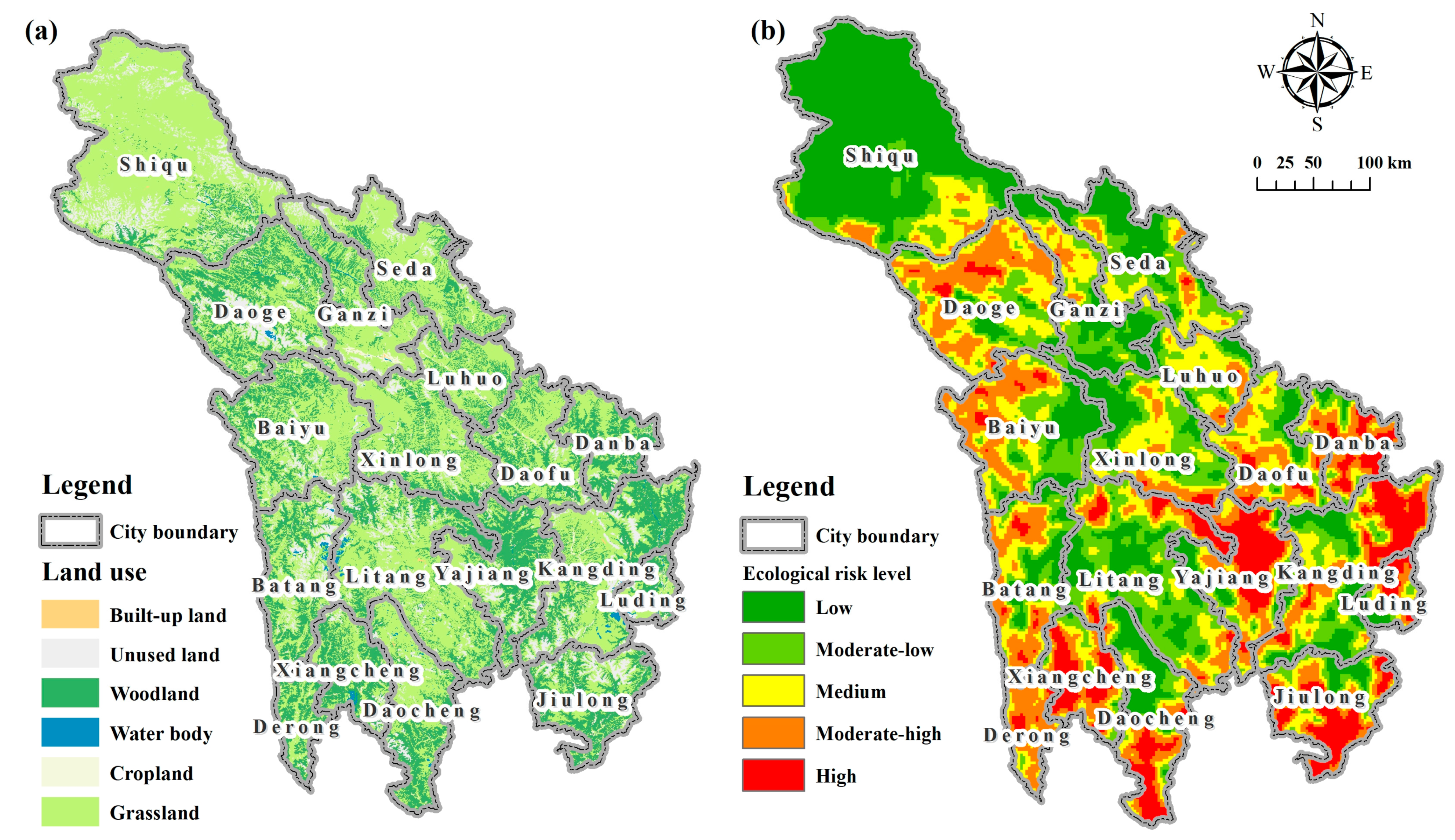
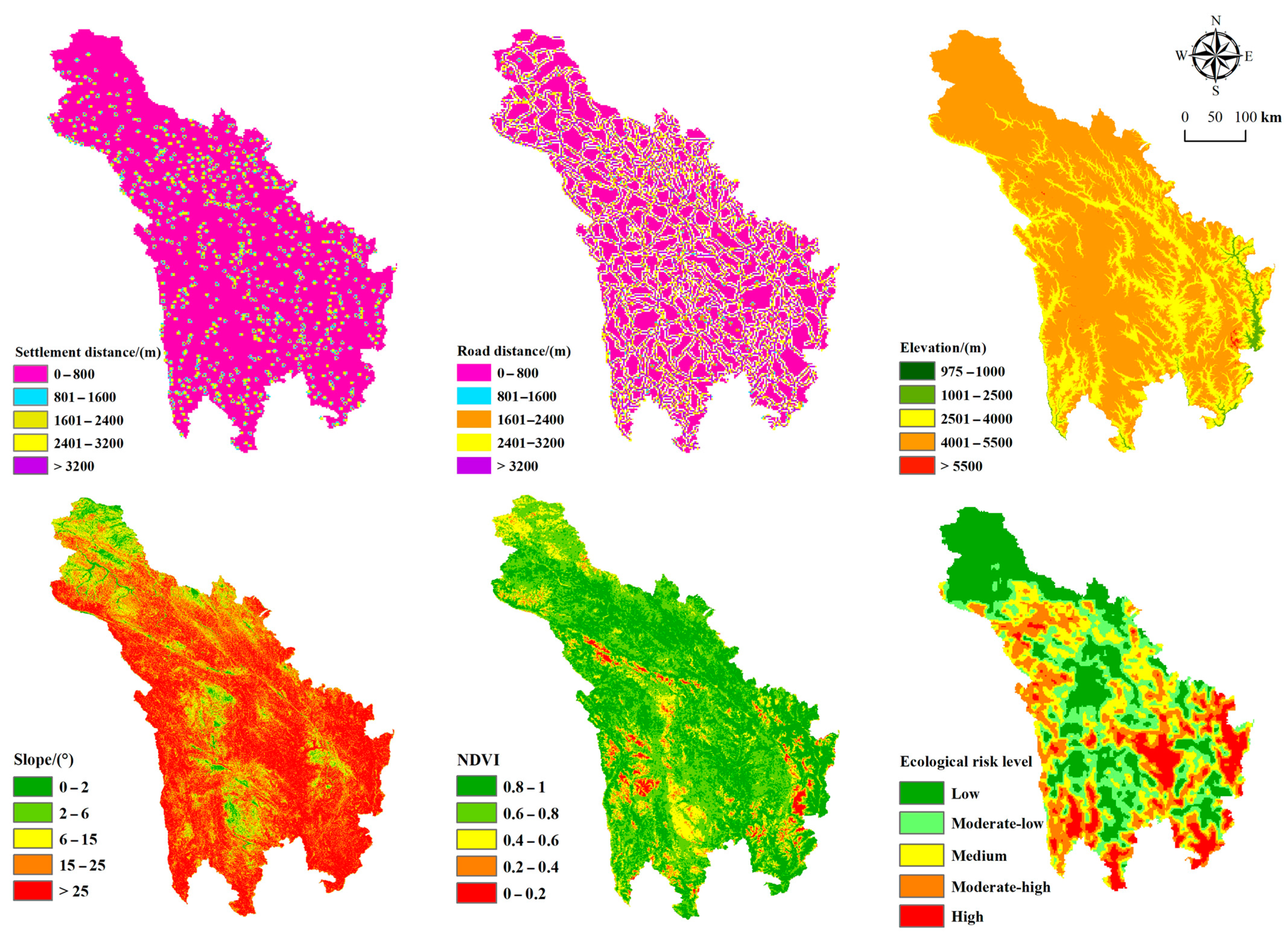
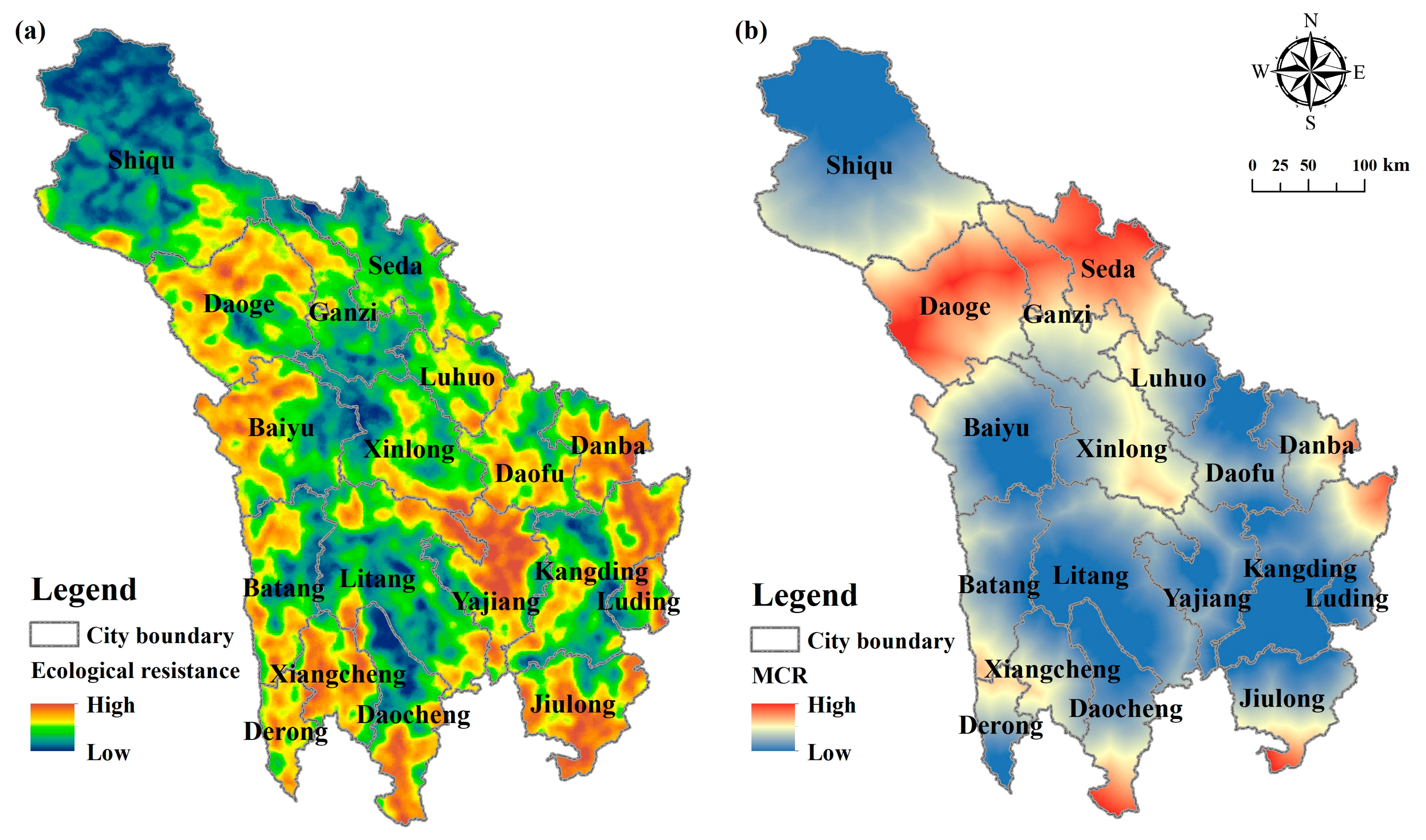
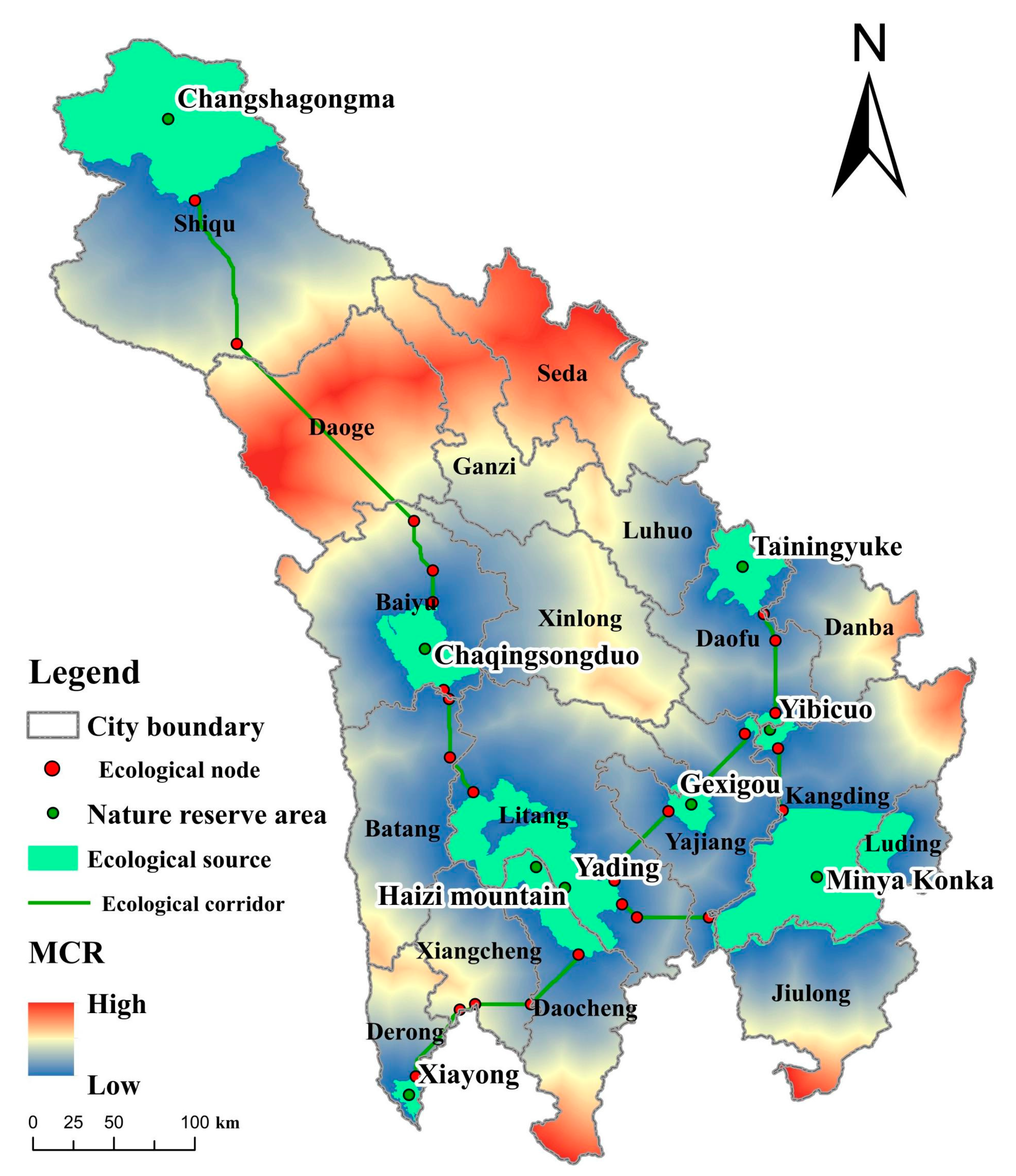
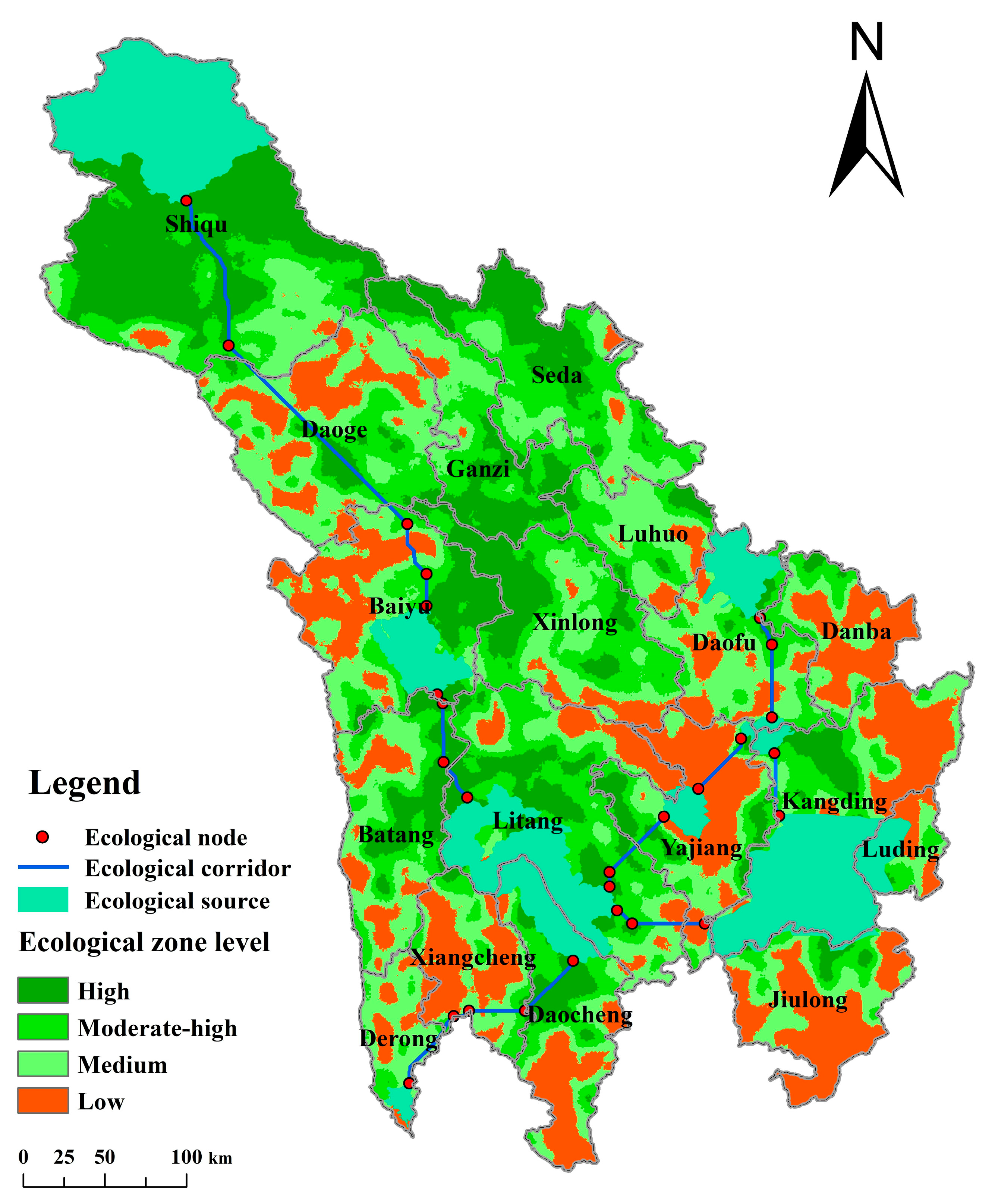
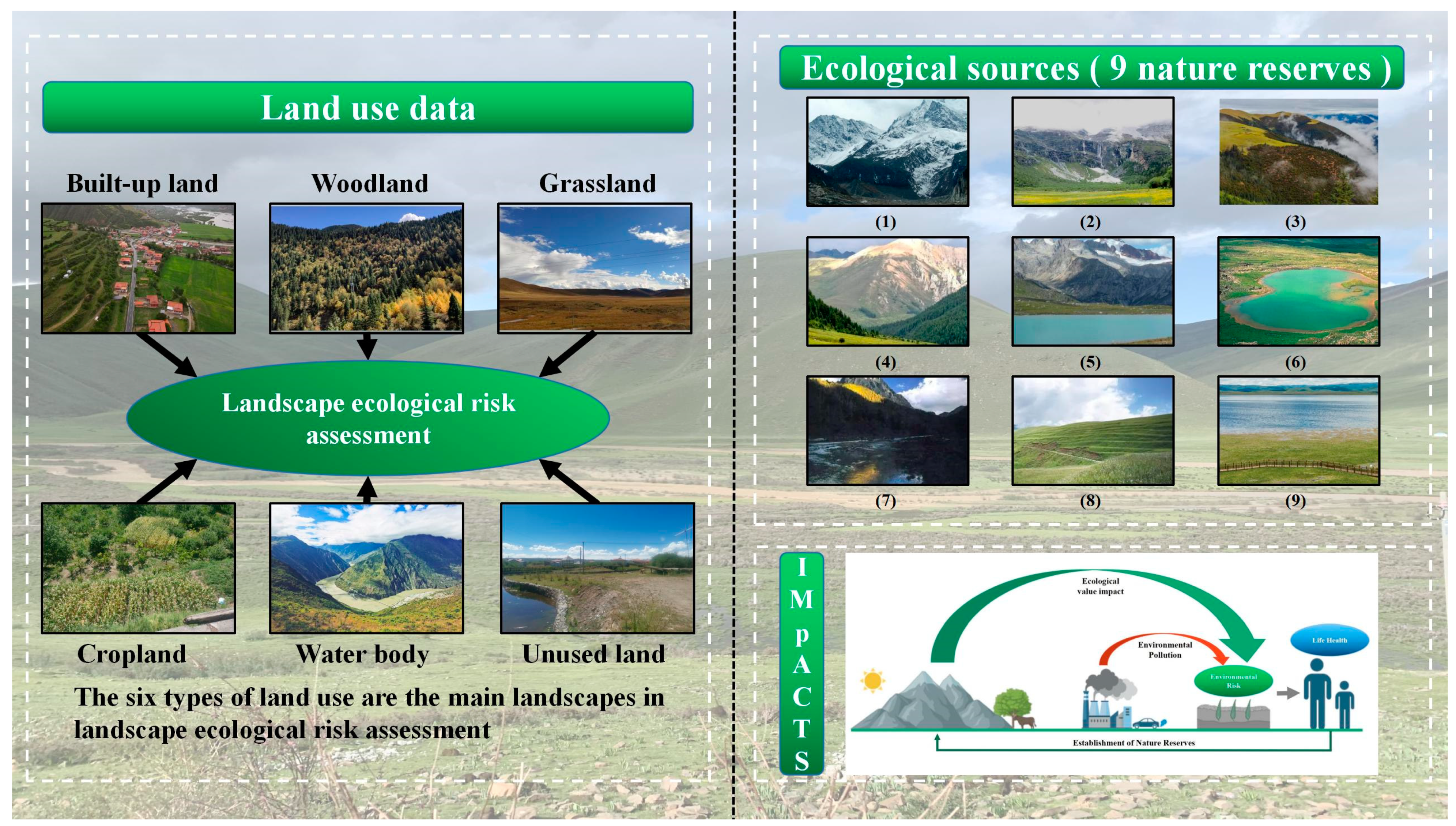
| Number | Name | Type | Grade | Area (km2) |
|---|---|---|---|---|
| 1 | Gongga Mountain National Nature Reserve | Forest Nature Reserve | Country | 5970.5 |
| 2 | Yading National Nature Reserve of Sichuan Province | Forest Nature Reserve | Country | 1449.92 |
| 3 | Gexigou National Nature Reserve | Animal Nature Reserve | Country | 551.82 |
| 4 | Chaqingsongduo National Nature Reserve | Animal Nature Reserve | Country | 1570.33 |
| 5 | Haizi Mountain National Nature Reserve | Wetland Nature Reserve | Country | 4628.37 |
| 6 | Changshagongma National Nature Reserve | Animal Nature Reserve | Country | 6662.09 |
| 7 | Xiayong Nature Reserve | Forest Nature Reserve | Province | 234.97 |
| 8 | Tainingyuke Nature Reserve | Forest Nature Reserve | Province | 1340.97 |
| 9 | Yibicuo Swamp-Wetland Nature Reserve | Wetland Nature Reserve | Province | 423.91 |
| Type | Resistance Factor | Resistance Value/Grade | Weight | Attribute |
|---|---|---|---|---|
| Society | Distance to the settlements (m) | >3200/1; 2401~3200/2; 1601~2400/3; 801~1600/4; 0~800/5 | 0.0593 | - |
| Distance to the roads (m) | >3200/1; 2401~3200/2; 1601~2400/3; 801~1600/4; 0~800/5 | 0.0677 | - | |
| Landscape | Landscape ecological risk | low/1; moderate-low/2; medium/3; moderate-high/4; high/5 | 0.3576 | + |
| Normalized difference vegetation | (0.8, 1]/1; (0.6, 0.8]/2; (0.4, 0.6]/3; (0.2, 0.4]/4; (0, 0.2]/5 | 0.1866 | - | |
| Nature | Slope/(°) | (0, 2]/1; (2, 6]/2; (6, 15]/3; (15, 25]/4; >25/5 | 0.1596 | + |
| Elevation/m | 975~1000/1; 1001~2500/2; 2501~4000/3; 4001~5500/4; >5500/5 | 0.1692 | + |
| Landscape Type | Ci | Ni | Di | Ei | Fi | Ri |
|---|---|---|---|---|---|---|
| Cropland | 0.0132 | 0.5545 | 0.0578 | 0.0922 | 4 | 0.0176 |
| Woodland | 0.0027 | 0.0474 | 0.4394 | 0.0517 | 2 | 0.0049 |
| Grassland | 0.0004 | 0.0131 | 0.3235 | 0.0344 | 3 | 0.0049 |
| Waterbody | 0.0137 | 0.6648 | 0.0435 | 0.1075 | 5 | 0.0256 |
| Built-up land | 0.0411 | 3.8184 | 0.0112 | 0.5841 | 1 | 0.0278 |
| Unused land | 0.0026 | 0.0856 | 0.1246 | 0.0260 | 6 | 0.0074 |
| Ecological Risk | Area (km2) | Percentage of the Area (%) |
|---|---|---|
| Low | 42,108.95 | 27.45 |
| Moderate-low | 34,391.56 | 22.42 |
| Medium | 33,863.99 | 22.08 |
| Moderate-high | 28,179.74 | 18.37 |
| high | 14,847.16 | 9.68 |
| Ecological Security | Area (km2) | Percentage of the Area (%) |
|---|---|---|
| Low | 31,627.24 | 20.62 |
| Medium | 41,942 | 27.35 |
| Moderate-high | 37,557.68 | 24.48 |
| High | 42,264.47 | 27.55 |
Disclaimer/Publisher’s Note: The statements, opinions and data contained in all publications are solely those of the individual author(s) and contributor(s) and not of MDPI and/or the editor(s). MDPI and/or the editor(s) disclaim responsibility for any injury to people or property resulting from any ideas, methods, instructions or products referred to in the content. |
© 2023 by the authors. Licensee MDPI, Basel, Switzerland. This article is an open access article distributed under the terms and conditions of the Creative Commons Attribution (CC BY) license (https://creativecommons.org/licenses/by/4.0/).
Share and Cite
Ju, L.; Liu, Y.; Yang, J.; Xiang, M.; Xiang, Q.; Hu, W.; Ding, Z. Construction of Nature Reserves’ Ecological Security Pattern Based on Landscape Ecological Risk Assessment: A Case Study of Garze Tibetan Autonomous Prefecture, China. Sustainability 2023, 15, 8707. https://doi.org/10.3390/su15118707
Ju L, Liu Y, Yang J, Xiang M, Xiang Q, Hu W, Ding Z. Construction of Nature Reserves’ Ecological Security Pattern Based on Landscape Ecological Risk Assessment: A Case Study of Garze Tibetan Autonomous Prefecture, China. Sustainability. 2023; 15(11):8707. https://doi.org/10.3390/su15118707
Chicago/Turabian StyleJu, Lingfan, Yan Liu, Jin Yang, Mingshun Xiang, Qing Xiang, Wenkai Hu, and Zhengyi Ding. 2023. "Construction of Nature Reserves’ Ecological Security Pattern Based on Landscape Ecological Risk Assessment: A Case Study of Garze Tibetan Autonomous Prefecture, China" Sustainability 15, no. 11: 8707. https://doi.org/10.3390/su15118707
APA StyleJu, L., Liu, Y., Yang, J., Xiang, M., Xiang, Q., Hu, W., & Ding, Z. (2023). Construction of Nature Reserves’ Ecological Security Pattern Based on Landscape Ecological Risk Assessment: A Case Study of Garze Tibetan Autonomous Prefecture, China. Sustainability, 15(11), 8707. https://doi.org/10.3390/su15118707






